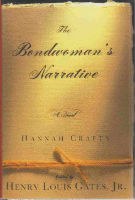 The Bondwoman’s Narrative tells the story of Hannah Crafts, a young enslaved woman working on a wealthy North Carolina plantation, who runs away in a bid for freedom up North.
The Bondwoman’s Narrative tells the story of Hannah Crafts, a young enslaved woman working on a wealthy North Carolina plantation, who runs away in a bid for freedom up North.
The Bondwoman’s Narrative is a best-selling novel by Hannah Crafts, written in the mid-19th century. Scholars believe that the novel, possibly the first written by an African-American woman, was created between 1853 and 1861. It is the only known novel by a fugitive enslaved woman, and it may precede the novel Our Nig by Harriet Wilson, published in 1859.
Henry Louis Gates, Jr. acquired the manuscript in 2001 in an annual auction by Swann Galleries. The catalogue described the novel as an “Unpublished Original Manuscript; a fictionalized biography, written in an effusive style, purporting to be the story, of the early life and escape of one Hannah Crafts.” Its history could be traced to the 1940s, when it was owned by African-American scholar Dorothy Porter. Gates bought the historic manuscript at a relatively low price of $8000. He proceeded to verify the text as an historical artifact, and drew on expertise by a variety of scholars. Crafts was believed to be a pseudonym of an enslaved woman who had escaped from the plantation of John Hill Wheeler. In September 2013, Gregg Hecimovich, a professor of English at Winthrop University, documented the novelist as Hannah Bond, an African-American enslaved woman who escaped about 1857 from the plantation of Wheeler in Murfreesboro, North Carolina. She reached the North and settled in New Jersey.
The 2002 publication includes a preface by Henry Louis Gates, Jr., describing his buying the manuscript, verifying it, and research to identify the author.
“A talented storyteller, Crafts appears self-taught and borrows from many sources–influences include other historical narratives, 19th-century sentimental and gothic novels and, as Gates noted in a letter to the New Yorker, Charles Dickens–she propels her story along, vividly describing the heroes and villains she entangles in her multiple plots.
A mulatto, Hannah grows up a domestic in Virginia, learning to read in secret. When her enslaver at last marries, Hannah becomes a maid to the new [enslaveress], a woman who seems haunted. In fact, she is hunted: someone who holds proof that her mother was enslaved is blackmailing her. Knowing her [enslaveress] will be sold if exposed, Hannah encourages her to flee, and flees with her. Thus begins Hannah’s journey, as she passes through the hands of prison guard, slave trader, benevolent caretaker, mean and petty [enslavers] and finally to freedom. The style is sentimental and effusive, but it is also winning. Crafts’s portrayal of the Wheelers–a small-minded but ambitious couple who prefer to “live at the public expense”–is incisive and utterly familiar.
Though Gates chose to touch up Crafts’s punctuation, he left her spelling as is and included her revisions, which were remarkably few. Crafts clearly understood the needs of her narrative and the conventions of the 19th-century novel in a way that many first novelists (of any century) don’t. While scholars will have to decide whether this is “the unadulterated `voice’ of the fugitive enslaved woman herself,” lay readers can simply enjoy Crafts’s remarkable story and Gates’s own story of discovering her.” –Publishers Weekly
Submit your review | |


